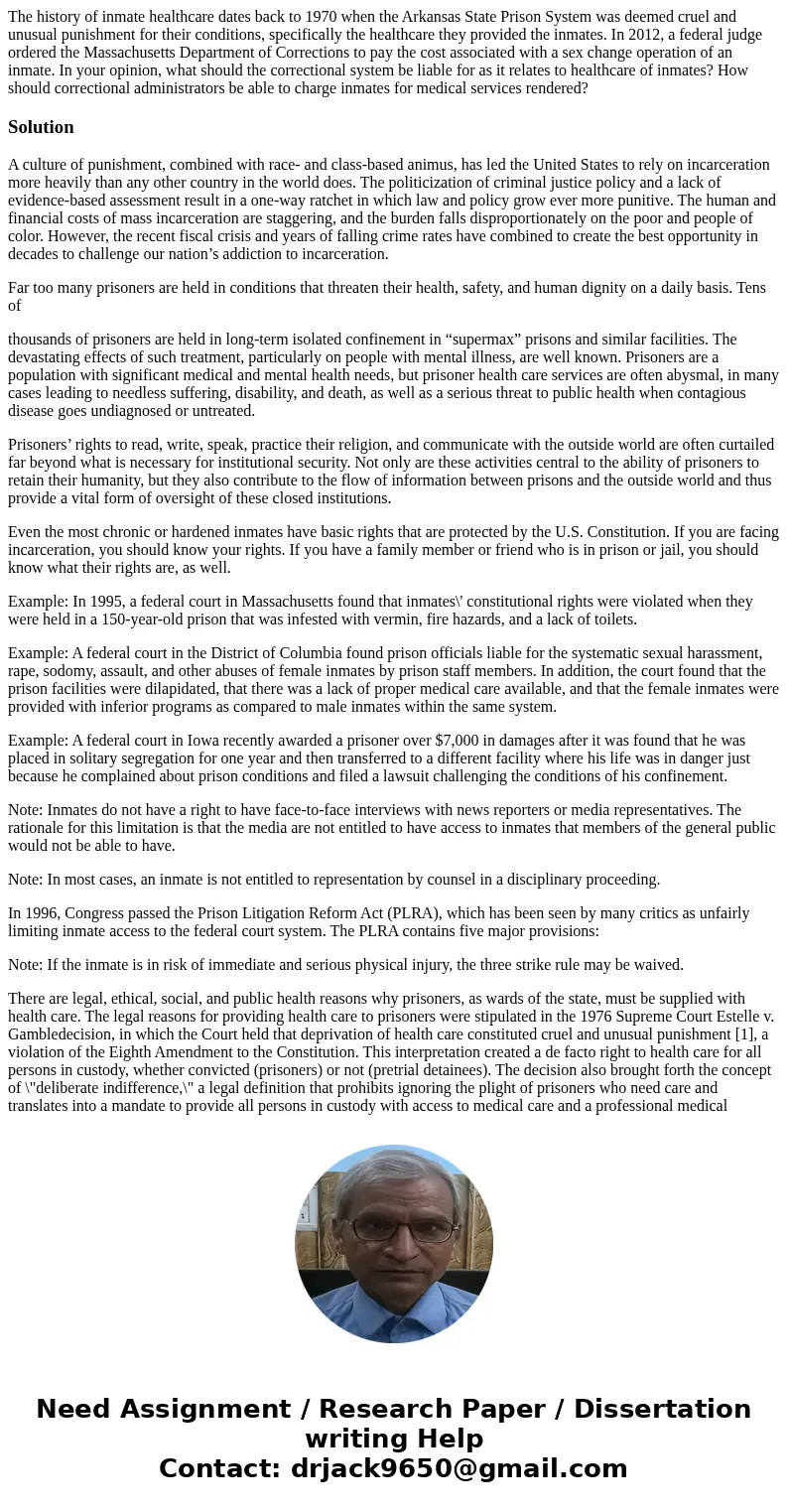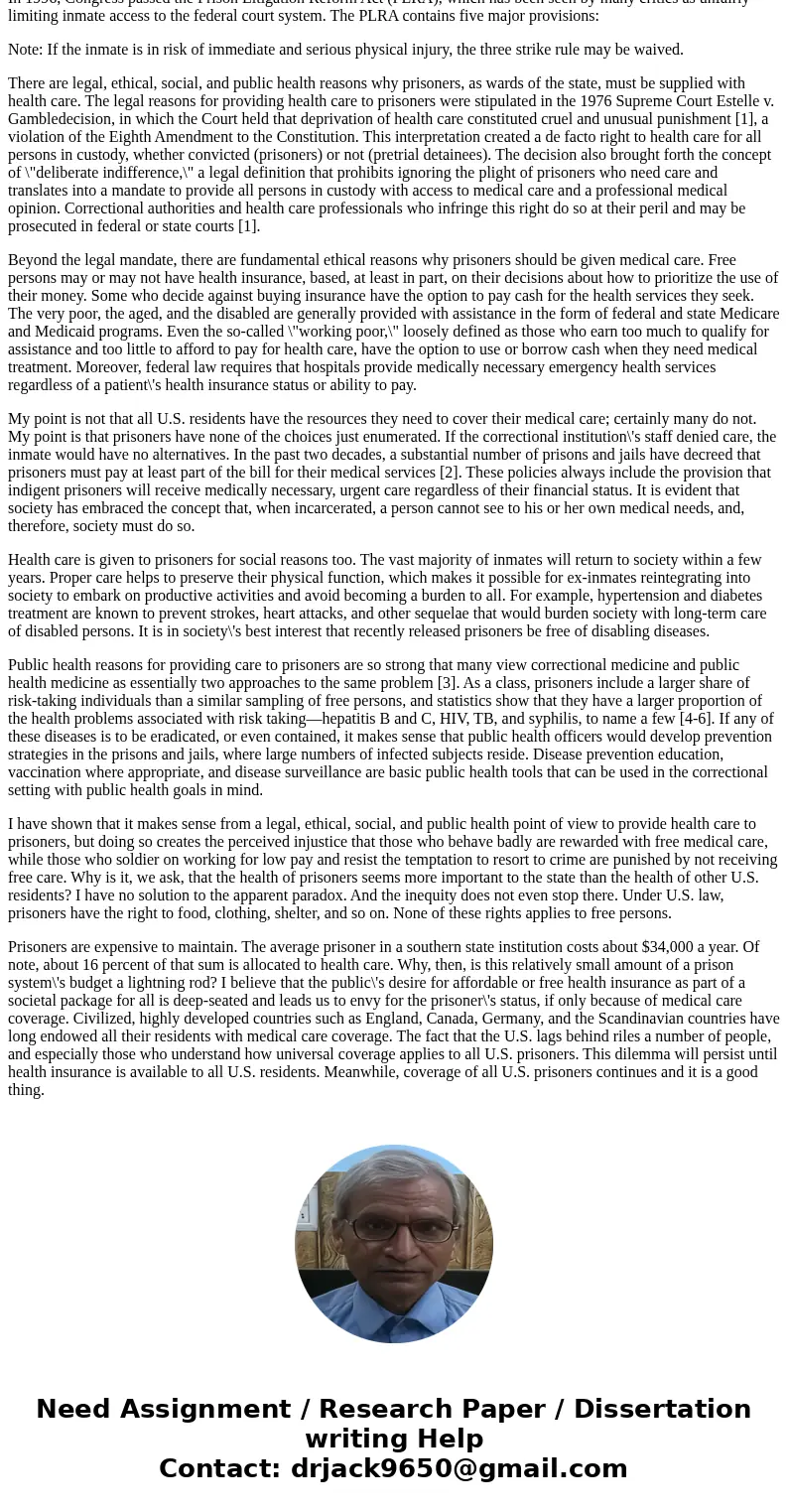The history of inmate healthcare dates back to 1970 when the
The history of inmate healthcare dates back to 1970 when the Arkansas State Prison System was deemed cruel and unusual punishment for their conditions, specifically the healthcare they provided the inmates. In 2012, a federal judge ordered the Massachusetts Department of Corrections to pay the cost associated with a sex change operation of an inmate. In your opinion, what should the correctional system be liable for as it relates to healthcare of inmates? How should correctional administrators be able to charge inmates for medical services rendered?
Solution
A culture of punishment, combined with race- and class-based animus, has led the United States to rely on incarceration more heavily than any other country in the world does. The politicization of criminal justice policy and a lack of evidence-based assessment result in a one-way ratchet in which law and policy grow ever more punitive. The human and financial costs of mass incarceration are staggering, and the burden falls disproportionately on the poor and people of color. However, the recent fiscal crisis and years of falling crime rates have combined to create the best opportunity in decades to challenge our nation’s addiction to incarceration.
Far too many prisoners are held in conditions that threaten their health, safety, and human dignity on a daily basis. Tens of
thousands of prisoners are held in long-term isolated confinement in “supermax” prisons and similar facilities. The devastating effects of such treatment, particularly on people with mental illness, are well known. Prisoners are a population with significant medical and mental health needs, but prisoner health care services are often abysmal, in many cases leading to needless suffering, disability, and death, as well as a serious threat to public health when contagious disease goes undiagnosed or untreated.
Prisoners’ rights to read, write, speak, practice their religion, and communicate with the outside world are often curtailed far beyond what is necessary for institutional security. Not only are these activities central to the ability of prisoners to retain their humanity, but they also contribute to the flow of information between prisons and the outside world and thus provide a vital form of oversight of these closed institutions.
Even the most chronic or hardened inmates have basic rights that are protected by the U.S. Constitution. If you are facing incarceration, you should know your rights. If you have a family member or friend who is in prison or jail, you should know what their rights are, as well.
Example: In 1995, a federal court in Massachusetts found that inmates\' constitutional rights were violated when they were held in a 150-year-old prison that was infested with vermin, fire hazards, and a lack of toilets.
Example: A federal court in the District of Columbia found prison officials liable for the systematic sexual harassment, rape, sodomy, assault, and other abuses of female inmates by prison staff members. In addition, the court found that the prison facilities were dilapidated, that there was a lack of proper medical care available, and that the female inmates were provided with inferior programs as compared to male inmates within the same system.
Example: A federal court in Iowa recently awarded a prisoner over $7,000 in damages after it was found that he was placed in solitary segregation for one year and then transferred to a different facility where his life was in danger just because he complained about prison conditions and filed a lawsuit challenging the conditions of his confinement.
Note: Inmates do not have a right to have face-to-face interviews with news reporters or media representatives. The rationale for this limitation is that the media are not entitled to have access to inmates that members of the general public would not be able to have.
Note: In most cases, an inmate is not entitled to representation by counsel in a disciplinary proceeding.
In 1996, Congress passed the Prison Litigation Reform Act (PLRA), which has been seen by many critics as unfairly limiting inmate access to the federal court system. The PLRA contains five major provisions:
Note: If the inmate is in risk of immediate and serious physical injury, the three strike rule may be waived.
There are legal, ethical, social, and public health reasons why prisoners, as wards of the state, must be supplied with health care. The legal reasons for providing health care to prisoners were stipulated in the 1976 Supreme Court Estelle v. Gambledecision, in which the Court held that deprivation of health care constituted cruel and unusual punishment [1], a violation of the Eighth Amendment to the Constitution. This interpretation created a de facto right to health care for all persons in custody, whether convicted (prisoners) or not (pretrial detainees). The decision also brought forth the concept of \"deliberate indifference,\" a legal definition that prohibits ignoring the plight of prisoners who need care and translates into a mandate to provide all persons in custody with access to medical care and a professional medical opinion. Correctional authorities and health care professionals who infringe this right do so at their peril and may be prosecuted in federal or state courts [1].
Beyond the legal mandate, there are fundamental ethical reasons why prisoners should be given medical care. Free persons may or may not have health insurance, based, at least in part, on their decisions about how to prioritize the use of their money. Some who decide against buying insurance have the option to pay cash for the health services they seek. The very poor, the aged, and the disabled are generally provided with assistance in the form of federal and state Medicare and Medicaid programs. Even the so-called \"working poor,\" loosely defined as those who earn too much to qualify for assistance and too little to afford to pay for health care, have the option to use or borrow cash when they need medical treatment. Moreover, federal law requires that hospitals provide medically necessary emergency health services regardless of a patient\'s health insurance status or ability to pay.
My point is not that all U.S. residents have the resources they need to cover their medical care; certainly many do not. My point is that prisoners have none of the choices just enumerated. If the correctional institution\'s staff denied care, the inmate would have no alternatives. In the past two decades, a substantial number of prisons and jails have decreed that prisoners must pay at least part of the bill for their medical services [2]. These policies always include the provision that indigent prisoners will receive medically necessary, urgent care regardless of their financial status. It is evident that society has embraced the concept that, when incarcerated, a person cannot see to his or her own medical needs, and, therefore, society must do so.
Health care is given to prisoners for social reasons too. The vast majority of inmates will return to society within a few years. Proper care helps to preserve their physical function, which makes it possible for ex-inmates reintegrating into society to embark on productive activities and avoid becoming a burden to all. For example, hypertension and diabetes treatment are known to prevent strokes, heart attacks, and other sequelae that would burden society with long-term care of disabled persons. It is in society\'s best interest that recently released prisoners be free of disabling diseases.
Public health reasons for providing care to prisoners are so strong that many view correctional medicine and public health medicine as essentially two approaches to the same problem [3]. As a class, prisoners include a larger share of risk-taking individuals than a similar sampling of free persons, and statistics show that they have a larger proportion of the health problems associated with risk taking—hepatitis B and C, HIV, TB, and syphilis, to name a few [4-6]. If any of these diseases is to be eradicated, or even contained, it makes sense that public health officers would develop prevention strategies in the prisons and jails, where large numbers of infected subjects reside. Disease prevention education, vaccination where appropriate, and disease surveillance are basic public health tools that can be used in the correctional setting with public health goals in mind.
I have shown that it makes sense from a legal, ethical, social, and public health point of view to provide health care to prisoners, but doing so creates the perceived injustice that those who behave badly are rewarded with free medical care, while those who soldier on working for low pay and resist the temptation to resort to crime are punished by not receiving free care. Why is it, we ask, that the health of prisoners seems more important to the state than the health of other U.S. residents? I have no solution to the apparent paradox. And the inequity does not even stop there. Under U.S. law, prisoners have the right to food, clothing, shelter, and so on. None of these rights applies to free persons.
Prisoners are expensive to maintain. The average prisoner in a southern state institution costs about $34,000 a year. Of note, about 16 percent of that sum is allocated to health care. Why, then, is this relatively small amount of a prison system\'s budget a lightning rod? I believe that the public\'s desire for affordable or free health insurance as part of a societal package for all is deep-seated and leads us to envy for the prisoner\'s status, if only because of medical care coverage. Civilized, highly developed countries such as England, Canada, Germany, and the Scandinavian countries have long endowed all their residents with medical care coverage. The fact that the U.S. lags behind riles a number of people, and especially those who understand how universal coverage applies to all U.S. prisoners. This dilemma will persist until health insurance is available to all U.S. residents. Meanwhile, coverage of all U.S. prisoners continues and it is a good thing.


 Homework Sourse
Homework Sourse